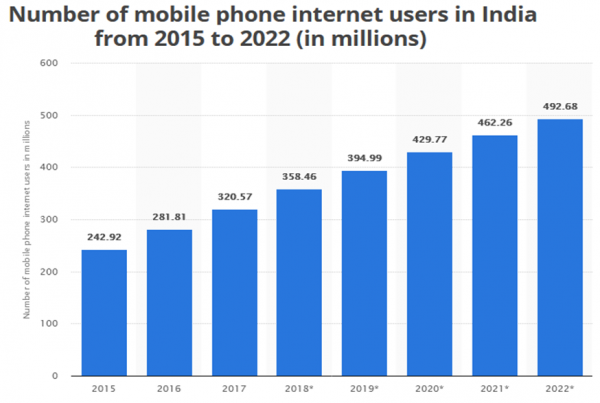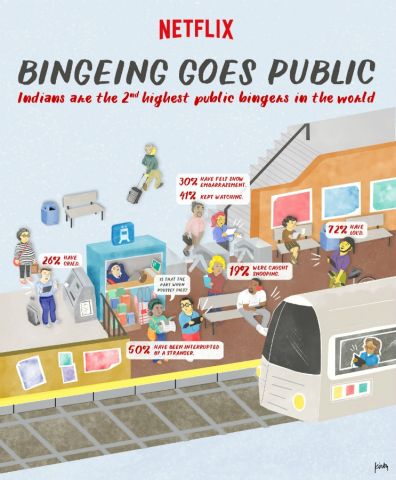From BIG DATA to Small Cinema? Challenges & Opportunities of Cinema in New Media
With the expanse of digital technologies and internet there is a lot of data for every individual – be it taste, behavioural pattern or even social sentiment. This ‘big’ data is harnessed by companies as customer targeting has reached a new aggression. Cinema not only gets changed continuously with respect to the format and projection technologies but the bigger question is with so much information about the audience preferences whether cinema is actually becoming ‘small’.
The age of New Media is fascinating, baffling and complex. To interpret it is difficult primarily because it is something that is happening right now, at this very moment – it is nothing but LIVE. Observing any ‘happened’ (not ‘happening’) phenomena from a retrospective distance so that we can dissociate us from it and judge it rationally is probably far easier. There is no wonder that being an art form that has continuously evolved with technology, ‘cinema’ has been affected by the evolution of New Media and its auxiliaries.
In this scenario, in the context of India primarily I will try to focus on 2 aspects of New Media and observe, rather question, how it, if at all, affects cinema. Even before we delve deeper into the topic let us assume, as a preamble, that the most prevalent example of New Media in today’s world is the ‘Internet’. And which device holds it best? – none other than the smartphones around us from the different brands but with similar screen-sizes, resolutions and features.
Mobile Internet: The Indian scenario
As per the Press Release Number 40/2019 on 21 May 2019 of the Telecom Regulatory Authority of India (TRAI), the Telecom Subscription data on 31 March 2019, records 1.16 Billion wireless telephony subscribers with a Broadband subscription of 563 million. More interestingly, out of the 1.16 Billion wireless subscribers, 0.65 Billion are Urban and 0.51 Billion are Rural subscribers.
Statista, the statistics portal which is a leading provider of market and consumer data has made a detailed study on the internet usage in India. As part of the report the firm has provided with a projection of the number of mobile internet users in India from 2015 to 2022. As per their projection, 430 million Indians will access the internet through their mobile phones by 2020.

These two statistics clearly state us that from the perspective of how technology and telecom spectrum is penetrating the population, India is at a threshold of being termed an ‘emerged’ market rather than an ‘emerging’ one. This boom of mobile telephony and the internet ensure that the giant nation is slowly but surely getting addicted to the small screen.
The speed at which the Internet spectrum is expanding is faster than the literacy growth of the country. A large percentage of rural India is illiterate and for that population learning the language and then learning to use computers is a double dampener. Yet, the rate of mobile usage is increasing in rural areas also. Smartphones coupled with low mobile tariffs have been the game-changer here. The future of mobile internet will open up new avenues of accessing information and data through the use of voice, vernacular keypads and apps that access high-speed wireless internet spectrum like 4G, 5G and so on.
It has to be borne in mind that the internet-enabled mobile platform is the superior bridge for the digital divide.
The Social Effect – Privatisation of Lives and ‘BIG’ Data
In this astronomical expansion of mobile internet we can find that everyone around us is hooked to his or her smartphone and more often than not watching anything audio-visual on it.
Every individual is unique with his or her preferences and choices. But suddenly we have more to consume – more technologies doing almost the same thing and also a plethora of devices, again with possible overlapping purposes. It is the internet-enabled smartphone which is in essence converging multiple requirements. It is blurring the boundaries as it serves the need of having a camera, a phone, a scanner, a movie-watching device, so on and so forth.
Due to this increased association with the mobile which is the most dynamic private accessory that one can think of today, social networking and e-marketing sites are generating huge information about the subscribers, their behavioural patterns, a phenomenon which is termed as ‘Big’ Data due to its heavy size.
What this has actually done is, it has made us lazy and transformed our bedrooms into media-rich workstations. In the process, our lives are becoming more and more private. Our children are not spared from it either. They are more interested in glueing themselves to the tabs and smartphones, thereby becoming unhealthy, obese and essentially blunt.
But this privatisation does give us a sense of empowerment as well. We feel that since all our unique choices are being listened to, we have a ‘voice’ and an ‘importance’. In providing us with this ‘customised’ platter service providers and organizations in the partnership are tracking our browsing patterns, histories and in a sense creating a profile of each of us. That is why the advertisements appearing on the same website may differ between users based on their individual digital footprints in the cyberspace.
Due to this increased association with the mobile which is the most dynamic private accessory that one can think of today, social networking and e-marketing sites are generating huge information about the subscribers, their behavioural patterns, a phenomenon which is termed as ‘Big’ Data due to its heavy size.
Keeping these aspects in mind let us now analyse how the rise of internet on the mobile smartphones resulting in generation of BIG consumer data tends to dictate the future of cinema.
Effect on Cinema: 1) Watching AV on a Smartphone
With the rise of mobile internet and low data tariffs, most of us have developed a habit of consuming a huge amount of audio-visual content from the smartphone screens on a daily basis. This not only includes YouTube videos and film songs but also full-length feature films apart from web-series and TV serials.

For many of us, even a recent-released film is only watched via the smartphone screen courtesy Netflix, Hotstar, Amazon Prime and the likes. Does this mean that traditional cinema’s technical characteristics need to change to make this mobile viewing more convenient? Does it also mean that certain scenes typically outdoor landscape ones in longshots or wide angles may be rendered ‘ineffective’ within the small contours of a smartphone and this essentially will dictate the script-writing process in future?
Psychological aspect
From a psychological perspective, in the earlier days movie theatres always used to provide a mesmeric appeal – that larger-than-life feeling. With TV and the unending serials being aired multiple times in a day there is a regular, daily bonding with the on-screen characters. Not only because of their frequent availability making them less demanding but also because of the size of the TV screen that the characters become smaller in stature. They are more commonplace, readily accessible losing that elusive ‘star-appeal’ of the silver screen.
Now with the smartphones, the screens have shrunk further and fitted into the palm of the viewer. One has the power to start, stop or even mute the Demigods with the tap of his/her finger. Literally and metaphorically the superstars of cinema, and cinema itself is at the mercy of the viewer. To me, it is as if a reverse journey of Gulliver – from the land of the Giants to that of the Lilliputs.
I fear, in a way, the grandeur of cinema gets compromised as the screen is reduced to a palm-held device.
Technical aspect
But there is another side to the story as well apart from the metaphorical shrinking of the cinematic screen. When TV first came into being it had an aspect ratio of 4:3. For earlier films of the early 50s and around, it didn’t create much of a problem apart from the physically reduced size of the TV screen. But as a competition to curb the popularity of TV when the Cinemascope “Widescreen” film formats were used, watching those films on the 4:3 TV screens became difficult. For example, if we watch Ben Hur or Lawrence of Arabia on TV this would necessarily mean panning and scanning or letterboxing which gives a different physical viewing experience.
(Netflix will explore mobile-specific cuts of its original series)
Will this actually make film-makers choose 16:9 or 18:9 over 2.39:1? It may well be. More importantly, soon we may have two versions of almost every film – one for the theatre release and the other for the mobile screen. If that day comes, and with the crumbling of the physical spaces under the weight of the virtual ones my fear may become a cruel reality.
Both psychologically and technologically then, the boom of mobile internet and the rise of watching AV on the smaller screen together will render cinema ‘small’.
Effect on Cinema: 2) Rise of BIG data
We have already discussed how in today’s digital world we constantly leave behind digital trails when we carry out transactions online – GPS geo-tagging, swiping our cards, being active on Facebook or Twitter and so on. By offering and making digital synchronization possible, not only are the telecom service providers increasing their revenues but more importantly, they are harnessing the nation’s digital data into a phantom store. This is a circular, cyclical inclusion of individuals as mere agents of data as a creator and thereby a consumer.
There are multiple online retailers who provide additional discounts on retail items when items are bought through their mobile apps instead of the online websites accessed from a desktop or a laptop computer. This is because of the philosophy that relates the consumer data with individuals who are more than just face-less email ids in the virtual space. Consider the amount of data that is tagged to an individual based on his/her buying patterns, search patterns and social behaviour patterns the moment the person’s phone and mobile numbers are correlated and identified. This provides a 360-degree customer profile which is why you find advertisements for the book you browsed on Amazon on your Facebook wall. And, this is the reason why Gmail, Facebook and the likes keep pestering you for your mobile number every now and then.

Based on audience sentiments and consumer profiling, marketing strategies are being decided not only for retail products but also in the distribution of cinema in traditional theatre halls. Two Hindi films are to be noted here:
Raam Leela (2013) – a prediction framework was put in place that analysed more than seven lakh posts across Facebook, Twitter, YouTube, etc for 25 Bollywood films with considerable social buzz.
Chennai Express (2013) – 1 billion cumulative impressions from over 750 thousand tweets during a 90-day campaign period were collected and analysed.
This social media analytics eventually resulted in:
* Fine-tuning the products before release
* Decision on the most appropriate release dates
* Decision on release locations in places which generated positive sentiments
Not only the social media sentiments, but BIG Data also includes a huge amount of data (and hence information) on existing products. It is believed that Netflix categorises each film into tens of thousands of attributes so that micro-level choices can be identified.
A case study worth mentioning here that leverages this huge historical data of already released cinema and AV is the making of the theatrical trailer of Hollywood film Morgan. A suspense/horror film that it is, a cognitive movie trailer was developed for it using machine learning in IBM Watson machine. Apparently, the research team trained the AI system on scenes from “100 horror movies.” Once the system gained an understanding of the types of scenes found in a standard suspense/horror movie trailer, it was given the full-length film and recommended 10 moments for the Morgan trailer. A total of six minutes of footage was pulled from the 90-minute movie. With all of these, the trailer was made ready in 24 hours from start to finish thereby cutting the cost on resources and time.
If we then combine these two aspects – Content profiling of already existing films and Audience profiling of their behaviour, a day may not be distant when there will be ready-made recipes for a successful film in any genre. Will creativity be compromised? Will the director’s ability to experiment and take risks to be further limited by the burden to make his/her film a Box-office hit? Will the studios hope to choose and tailor their movies from the very start, and perhaps even identify some kind of magic formula to screenwriting?
Will it not again make the future of cinema limited and the future cinema ‘small’?
Steve Jobs, the maverick supremo of Apple Inc. turned Apple products into a global brand not by simply providing people with their own conscious wish and need. What he did was to make us imagine what we never knew we wanted or even better, something which we never dared to dream to be true.
Last year was the 100th birth anniversary of Ingmar Bergman who once famously said – “The Human face is the most cinematographic thing that exists because it changes the whole time”. Bergman’s cinema and that of a few others as well hold the human face as a canvas for myriad emotions. Emotions that sway us with their veracity and passion. Which 6-inch screen will grasp us with the same captive attention trapped within our palm?
With trillions of data on content, on consumer profiles, with more and more sophisticated mobile screens having larger and larger pixels per inch, still, the big screen will probably survive. Because, even after all of these the human penchant to reach out to the stars will remain. For, cinema has always been big and will probably remain so – it’s the technologies that only got ‘small’.
With the expanse of digital technologies and internet there is a lot of data for every individual – be it taste, behavioural pattern or even social sentiment. This ‘big’ data is harnessed by companies as customer targeting has reached a new aggression. Cinema not only gets changed continuously with respect to the format and projection technologies but the bigger question is with so much information about the audience preferences whether cinema is actually becoming ‘small’.
This article is based on a presentation that was delivered at a Symposium at Satyajit Ray Film and Television Institute (SRFTI), Kolkata on 24 July 2018. The title of the symposium was “Cinema in the age of New Media: Challenges & Opportunities.” It was originally published in Silhouette Magazine on 21 June, 2019. (https://learningandcreativity.com/silhouette/from-big-data-to-small-cinema-challenges-opportunities-of-cinema-in-new-media/ )
Tags
About the Author

Amitava Nag is an independent film critic and editor of film magazine 'Silhouette' (www.silhouette-magazine.com) since 2001. Till date Amitava has authored 5 books on cinema including 'Satyajit Ray's Heroes and Heroines', '16 Frames' and 'Beyond Apu: 20 Favourite Films of Soumitra Chatterjee'. Amitava also writes poems and short fiction in Bengali and English and authored a collection of short stories each in English and Bengali, and an anthology of Bengali poems.His first anthology of English verses and a selected translation of Soumitra Chatterjee's poems are awaiting publication.







.jpg)


